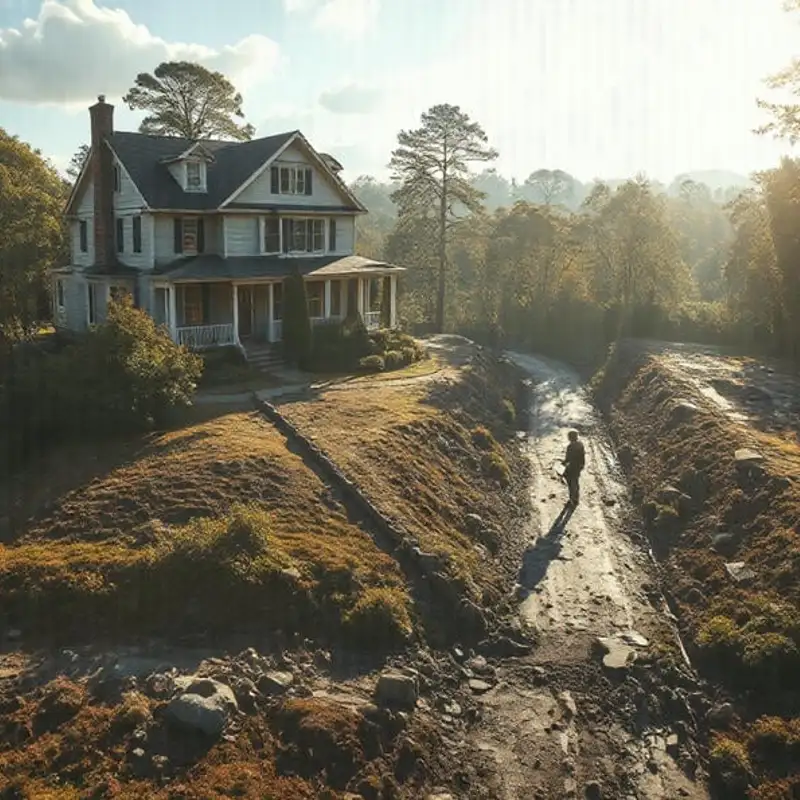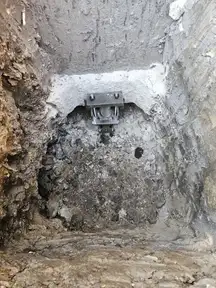
Moisture: The Silent Foundation Assassin
Welcome back to "Strong Foundations, Strong Homes," the podcast where we talk about the only relationship more complicated than your last date – the one between you and your house's foundation. I'm your host, Alex Morrison, coming to you from my basement studio where, ironically enough, I'm staring at a suspicious water stain that appeared after last week's thunderstorm. Perfect timing for today's topic, wouldn't you say?
Today, we're diving into – pun absolutely intended – the wettest, wildest threat to your home's structural integrity that isn't a toddler with a garden hose: moisture. That's right, folks. That innocent-looking dampness in your basement corners? It's basically the horror movie villain of home ownership. It starts with a tiny puddle that you conveniently ignore, and before you know it, you're living in the Leaning Tower of Split-Level Ranch.
Now, I learned this lesson the hard way. Two springs ago, I noticed this peculiar earthy smell in my basement. Not unpleasant exactly – kind of like a forest after rain – and I actually convinced myself it was a charming feature of our 1970s home. "Authentic vintage basement aroma," I called it when showing friends around. Turns out, what I was actually giving tours of was active water infiltration slowly turning my foundation into the structural equivalent of a soggy graham cracker.
But I'm not going to navigate these troubled waters alone. Today I'm joined by someone who speaks fluent "moisture management" – Dr. Elaine Richards, geotechnical engineer and founder of Dry Base Solutions, who has spent twenty years helping homeowners whose foundations are secretly auditioning for "Waterworld: The Home Edition." Elaine, welcome to the show!
Thanks for having me, Alex. And I have to say, your "vintage basement aroma" description is something I hear at least three times a week from homeowners.
Oh good, so I'm not uniquely oblivious! That's actually comforting. So Elaine, help us understand – what makes moisture such a devious foundation assassin?
Well, water is patient. It's persistent. And it has absolutely nowhere better to be than working its way into your foundation. Think of water as that party guest who shows up uninvited, brings friends, and then refuses to leave.
I'm having flashbacks to my cousin's wedding after-party...
Exactly! Now imagine that party guest can also change the physical properties of your house's support structure. The biggest issue is that soil around your foundation expands when wet and contracts when dry. So your foundation is essentially sitting on a material that's constantly changing volume.
It's like building your house on a breathing organism. Which, now that I say it out loud, sounds like the premise for a Stephen King novel.
It's not far off. And that breathing – or cycling between wet and dry – puts enormous pressure on foundation walls. Concrete is strong in compression but weak in tension, so when that soil pushes against your basement walls or heaves upward beneath your slab, cracks develop.
Wait – so my morning shower ritual is betraying my foundation? That's cold. Metaphorically speaking, of course.
Well, proper ventilation helps with that. But yes, everything from your shower steam to the way your gutters direct water can impact your foundation's moisture exposure.
Speaking of exposure, I made the rookie mistake of ignoring some pretty obvious signs that my foundation was secretly swimming. Listeners, let me save you from my damp fate – what warning signs should homeowners be looking for?
The classics are visible water or dampness, obviously. But before it gets that obvious, you might notice efflorescence – those chalky white deposits on concrete that look like your foundation developed dandruff.
I thought that was basement confetti! Shows how much I knew.
Nature's confetti for foundation problems! Another sign is doors and windows that suddenly stick or won't close properly. As moisture affects your foundation, the entire frame of your house can shift slightly.
That explains why the guest bedroom door started catching on the carpet last spring. I just shimmed the hinges and considered it fixed. Apparently, I was just treating the symptom while the disease was having a pool party in my foundation.
Classic homeowner move. You also might notice musty odors, mold or mildew growth, or even insects and pests that are attracted to damp environments.
Let's not talk about the centipedes. I'm still traumatized. But speaking of trauma, we received a voice message from a listener in Boise that I think perfectly captures the psychological toll of discovering you have a moisture problem. Let's listen.
Hi Alex! This is Barbara from Boise. I just had to share this after your newsletter mentioned today's topic. For months, I was convinced my basement was haunted. Items would move slightly out of place, there were these strange popping sounds at night, and sometimes the door to the upstairs would close by itself. I was ready to call an exorcist until my neighbor, who's a contractor, pointed out that my foundation was shifting due to improper drainage. Turns out the ghost was just hydrostatic pressure! Who knew physics could be so spooky? Love the show!
Barbara, I feel you on a spiritual level. My own house makes more unexplained noises than a found-footage horror film, and half of them probably trace back to moisture issues. So Elaine, now that we've thoroughly terrified everyone about the state of their foundations, let's talk solutions. How do we wage war against this watery menace?
The good news is that many moisture issues can be addressed with relatively simple interventions. The first line of defense is proper grading and drainage around your home.
My adventure with grading was anything but simple. I rented a mini excavator – which, by the way, is dangerously fun to operate – with the intention of creating a gentle slope away from my foundation. What I actually created was something my neighbors now refer to as "Morrison's Moat."
That's... creative landscaping.
The neighborhood kids love it when it rains. My homeowner's insurance, not so much.
Well, proper grading should have a slope of about one inch per foot for at least six feet around your foundation. No moats necessary.
Now you tell me. What about gutters? I'm assuming they play a role too?
Crucial role. Your gutter downspouts should discharge water at least six feet away from your foundation. Extensions are cheap insurance against major foundation problems.
Mine now extend into my neighbor's yard. I'm kidding! Mostly. I do have those roll-out plastic extensions that I routinely trip over in the dark. Safety and foundation protection in one attractive package.
Just make sure they're actually deployed when it rains. I can't tell you how many homes I've visited where the homeowner has beautiful downspout extensions... neatly rolled up and stored when storms hit.
I feel personally attacked by that observation.
We're talking with Dr. Elaine Richards about moisture management for your foundation. Elaine, what about more high-tech solutions? I've seen advertisements for interior drainage systems that look like something out of a sci-fi movie.
Interior drainage systems can be very effective, especially in existing homes with chronic water issues. They typically involve installing a perforated pipe beneath the perimeter of your basement floor to collect water and direct it to a sump pump.
I had a sump pump installed last year, and let me tell you about the Great Power Outage of 2023. Three days, no electricity, during the wettest April on record. I was literally bailing water with a cooking pot every two hours like some sort of deranged sailor. Battery backups, people. Learn from my mistakes.
Battery backups are essential, or even water-powered backup pumps in areas with municipal water supply. The point is redundancy – you don't want to be that person forming a bucket brigade in your basement at 3 AM.
Too late! So what about those waterproofing coatings I see at hardware stores? Are they worth it, or am I just painting my problems a lovely shade of "still leaking"?
Interior sealants have their place, but they're treating symptoms, not causes. They can resist minor moisture penetration, but they won't hold back actual water pressure. If water is coming through your foundation, you need to address why it's getting there in the first place.
That's disappointingly logical. I was hoping for a magic paint solution. At what point should homeowners call in professionals like yourself?
Any time you have standing water, active leaks, or structural cracking, it's time for a professional assessment. Also if you've tried the basic interventions like improving drainage and the problem persists.
I waited until I found mushrooms growing in my carpet padding. Not recommended.
Definitely not ideal timing. Though you'd be surprised how often I hear similar stories.
Speaking of surprising stories, you mentioned off-air that you've seen some pretty dramatic foundation rescues in your career. Care to share one that stands out?
There was a craftsman bungalow in Portland where the owners had been battling basement flooding for years. Previous contractors had installed three separate sump pumps – all running constantly. When we investigated, we discovered an actual underground spring that had been diverted during the neighborhood's development in the 1920s. It was running directly beneath their home.
No way! Like, an actual spring? What did you do?
We ended up designing a custom drainage field that essentially created a channel around and under the foundation to divert the spring water. It was like building a mini aqueduct. That house went from pumping out thousands of gallons daily to being completely dry.
That's restoration heroism right there. Though I imagine it wasn't a budget solution.
Not exactly, but still cheaper than the foundation replacement they were facing if the moisture issues continued.
Fair point. Before we wrap up, I'd love to get your top three takeaways for our listeners on moisture management. The wisdom distilled, if you will.
First, prevention is infinitely cheaper than cure. Maintain your gutters, grade properly, and keep water away from your foundation.
Second, monitor vigilantly. Small changes like new cracks or dampness are your early warning system – don't ignore them.
And third, understand your specific situation. Different soil types, climates, and home constructions face different moisture challenges. What works for a home in Arizona won't necessarily work in Seattle.
That's fantastic advice. My personal reflection after finally addressing my foundation moisture issues is that it's like my house finally went to therapy. The random creaking has decreased, doors close properly again, and that persistent musty smell has vanished. It's amazing how much your home's physical and metaphorical foundation affects everything else.
Dr. Elaine Richards, thank you for being our moisture management guru today. Where can people find you if they want to learn more?
My company website is DryBaseSolutions.com, and I also have a YouTube channel called "Foundation Fundamentals" where I walk through common issues and fixes.
Wonderful! And listeners, next week we'll be tackling "Foundation Repair on a Budget: When DIY is DOA." I'll be sharing my own cautionary tale involving a tube of hydraulic cement, a YouTube tutorial, and what my contractor later described as "the most creative application of waterproofing I've ever had the misfortune to chisel off."
Share your own moisture horror stories on our website for a chance to win a professional-grade moisture meter – the most exciting tool you never knew you needed. Until next time, remember what my grandfather always said: "A solid foundation isn't just good life advice – it's the difference between a home and an expensive boat." This is Alex Morrison, signing off.
